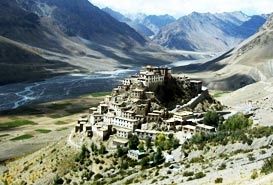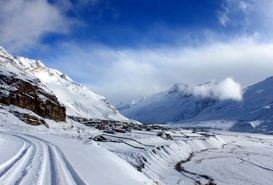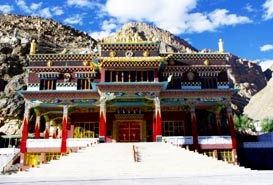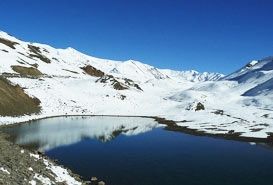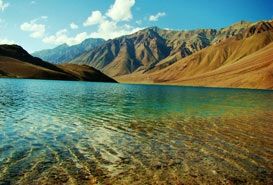Tabo Village in Spiti valley has a beautiful attraction: the Tabo Monastery. The Tabo Chos-Khor Monastery was established more than a millennium back, in 996 A.D., the Year of the Fire Ape by the Tibetan Calendar.
Location of Tabo Monastery Spiti
Tabo Monastery lies in the barren, snow-covered, cold desert. The altitude of Tabo Valley is 3050 m. Unscathed by any modern curses, it is a heaven in its sense. It has preserved Buddhism’s magnificent heritage, traditions, and culture through the passage of centuries, withholding its sanctity.
History of Tabo Monastery Spiti
In the entire Himalayan region, the Tabo Gompa is second most important to the Tholing Gompa in Tibet. The King of the western Himalayan Kingdom of Guge, Lotsawa Rinchen Tsang Po, developed the monastery as an advanced center for learning. Many great scholars and translators in Buddhist history studies were hosted for a significant period. Another name for Tabo Monastery is the preserver of the Buddhist Legacy. It remains one of the most crucial Gompa of the Tibetan Buddhist world.
The Tabo Monastery temples preserve a priceless collection of manuscripts and thangkas (Buddhist scroll paintings), beautiful statues in stuccos, frescos, and murals illustrating tales from the Mahayana Buddhist Pantheon. In addition, beautiful fine paintings in well-preserved condition cover every inch of the wall.
Explore 24 days Spiti Valley Road Trip From Delhi.
Did You Know? Tabo Monastery is also given the sobriquet of the “Ajanta of the Himalayas”. Traces of rock paintings and sculptures are unearthed.
The temple complex is a historic treasure of India, protected by the Archaeological Survey of India. In addition, 36 almost life-size clay statues adorn the walls of the assembly hall. Above the monastic enclave are a series of caves used as dwelling units by the monks.
Temples of Tabo Monastery Spiti
The monastery complex holds 9 temples, 23 chortens, a monk’s chamber, and an extension that houses the nuns’ chamber.
The Nine Temples are:
- The Temple of the Enlightened Gods (gTug-Lha-khang)
This temple has the prominent figure of a four-fold figure of Vairocana. In Vajrayana Buddhism, he is regarded as one of the five spiritual sons of Adibuddha- who was the self-created elemental Buddha. A larger than life idol about two meters above the floor is depicted in a posture turning the wheel of law. Beautiful Kashmiri paintings of Buddha’s life grace the interiors.
- The Golden Temple (gSer-khang)
Once layered with gold, this temple was extensively renovated in the 16th century by Senge Namgyal, ruler of Ladakh. As a result, the walls and ceilings are covered with outstanding murals.
- The Mystic Mandala Temple (dKyil-kHor- khang)
This temple also goes by the name of Initiation Temple, as the initiation to monkhood takes place here. A massive painting of Vairocana surrounded by eight Bodhisattvasare worshiped.
- The Bodhisattva Maitreya Temple (Byams-Pa Chen-po Lha-khang)
An image of Bodhisattva Maitreya over six meters high dominates the temple. The beautiful display of murals adoring the inner walls depicts the monastery of Tashi-Chunpo and Lhasa’s Potala Palace.
- The Temple of Dromton (Brom-ston Lha khang)
Founded by Dromton (1008-1064 AD), an important disciple of Atisha, it is one of the earliest temples of Tabo. Intricate carvings and murals decorate every surface of the temple.
- The Chamber of Picture Treasures (Z’al-ma)
A kind of an ante room attached to the Enlightened Gods temple, The Chamber of Picture Treasures is covered with beautiful paintings of the Tibetan style.
- The Large Temple of Dromton (Brom-ston Lha khang)
The second largest temple in the complex, covering over 70 sq m, has the figure of Sakyamuni flanked by Sariputra and Maha Maugdalayana. The outer walls depict the revered eight Medicine Buddhas and Guardian Kings.
Browse through our Shimla tour packages from Kolkata, Shimla Tour Packages from Chandigarh, Manali tour packages from Delhi, Himachal tour packages from Indore, Himachal pradesh tour packages from Bangalore, Dalhousie tour packages from Mumbai.
- The Mahakala Vajra Bhairava Temple (Gon-khang)
Dedicated to the protective deity of the Galuk-pa sect, fierce deities fill the room. The temple also goes by ‘temple of horror’ and can only be entered after protective meditation.
- The White Temple (dKar-abyum Lha-Khang)
Beautiful murals and paintings decorate the walls of the temple. In addition, an ornate low dado is erected for the monks or nuns to lean against when mediating.
Since the founding of Tabo Monastery, not much has changed. The lamas still perform tantric rites in the temples. Chanting starts at 6 a.m. sharp. In addition, many festivals are held in the environs of the monastery, and the Tibetan monks perform traditional Buddhist songs and masked dances.
A tour of Spiti Valley remains incomplete if you have not explored the Tabo Monastery.
Check out our packages: Spiti valley tour packages, Sarchu tour packages, Nalagarh Tour Packages, Manikaran tour packages, Manali tour packages, Kufri tour packages, Keylong tour packages, Jispa tour package, Dalhousie tour packages, Himachal Pradesh tour packages.
Spiti Tour Packages
Complete Himachal Tour
10 Nights / 11 DaysDelhi – Shimla - Kufri – Manali - Rohtang Pass - Dharamshala - Dalhousie - ChandigarhFrom ₹38,000 Per PersonFrom ₹28,000 Per PersonPrice On RequestShimla Manali Honeymoon Package
6 Nights / 7 DaysDelhi - Shimla - Kufri - Manali - Rohtang Pass - ChandigarhFrom ₹29,000 Per Person
Why Book With Us
35+
Years of Travel Experience
100+
Travel Experts To Assist You
03+
Million Satisfied Guests
Ministry
of Tourism Accredited
- 5/5 Rating:
- 4/5 Rating:







